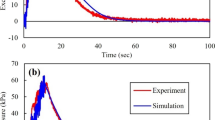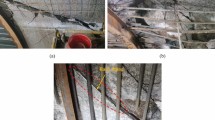Abstract
To better understand the mechanism of water inrush from fault zones, we investigated a typical inrush case from a coal mine in northern China, identified the water source and the role of fault zones, and analyzed the mechanical characteristics of the rock mass. We established a numerical model of fluid–solid coupling using finite difference methods based ideal elastic–plastic and Biot’s consolidation theories. The model considers softening effects caused by mine dewatering as well as the dynamic influence of mean principal stress and pore water pressure on fault zone permeability. It also simulates fault zone deformation, failure, and seepage under natural and disturbed-state conditions. The mechanism of water inrush through fault zones in a disturbed area was identified by comparing the deformation, failure, and seepage characteristics of fault zones with and without disturbance. The results show that deformation was concentrated at the bottom of the fault zone because of its naturally low strength, which created favorable conditions for water inrush. Softening of the media by mine dewatering also facilitated water inrush. Feedback effects between the fault zone and groundwater-enhanced permeability then led to groundwater bursting into the mine through the fault zone. This study provides an important framework for groundwater hazard prevention in similar mining areas.
抽象
为更好地理解断层突水机理,调研了中国北方煤矿典型的突水案例,了解突水水源和断层作用,分析岩体力学特性。基于理想弹塑性理论和Biot理论,采用有限差分法建立了流固耦合数值模型。模型考虑了矿井疏水引起的软化效应以及平均主应力和孔隙水压力对断层带渗透性的动态影响。模拟了自然条件和扰动条件下,断裂带的变形、破坏和渗透特性。通过对比有、无干扰条件下断裂带的变形、破坏和渗流特征,确定扰动区断裂带突水机理。结果表明,变形集于自然强度较低的断层带底部,使之更易于突水。矿井疏水引起的围岩介质软化也利于诱发突水。断层带及渗透性提高的反馈响应导致了地下水透过断层突入矿井。研究为类似矿区的地下水害防治提供了重要的理论依据。
Zusammenfassung
Zum besseren Verständnis der Vorgänge beim Wassereinbruch in Bergwerke durch Verwerfungszonen wurde ein typischer Fall in einem Kohlenbergwerk in Nordchina untersucht. Dabei wurde die Herkunft des Wassers identifiziert und der Einfluss der Verwerfungszonen untersucht. Ebenso wurden die mechanischen Eigenschaften der Felsmasse analysiert. Zu diesem Zweck wurde ein numerisches Modell mit Flüssig-Fest-Kopplung aufgebaut. Das Modell nutzt die Finite-Differenzen-Methode. Dabei stützt es sich auf die Plastizitätstheorie und die Konsolidierungstheorie nach Biot. Mit dem Modell können abschwächende Effekte durch Sümpfung ebenso wie der Einfluss der dynamischen Belastung und des Porenwasserdrucks auf die Permeabilität der Verwerfungszone simuliert werden. Weiterhin gestattet es die Simulation von Deformationen der Verwerfungszone, Materialversagen sowie Versickerung unter natürlichen und gestörten Bedingungen. Der Prozess des Wassereinbruchs durch Verwerfungszonen wird anhand des Vergleichs der Deformation, des Materialversagens und der Versickerungscharakteristika von Verwerfungszonen mit und ohne Störung erkannt. Die Ergebnisse zeigen, dass Deformationen hauptsächlich an der Unterkante von Verwerfungszonen stattfinden. Ursache ist ihre von Natur aus geringe Spannung, was den Wassereinbruch begünstigt. Ebenso begünstigt die Ausdünnung des Mediums durch Grubenwasserhaltung den Wassereinbruch. Rückkopplungseffekte zwischen der Verwerfungszone und der durch das Grundwasser gestiegenen Permeabilität führten zum schlagartigen Eindringen des Grundwassers durch die Verwerfungszone in das Bergwerk. Diese Fallstudie ist ein wichtiges Werkzeug zur Vorsorge von Grundwassereinbrüchen in ähnlichen Bergbaugebieten.
Resumen
Para comprender mejor el mecanismo de irrupción de agua de las zonas de fallas, investigamos un caso típico en una mina de carbón en el norte de China, identificando la fuente de agua y el papel de las zonas de falla y analizando las características mecánicas de la masa rocosa. Establecimos un modelo numérico de acoplamiento fluido-sólido utilizando métodos de diferencia finita basados en las teorías de elástico-plástico ideal y de consolidación de Biot. El modelo considera los efectos de ablandamiento causados por el desagote de la mina, así como la influencia dinámica del estrés principal y la presión del agua de los poros sobre la permeabilidad de la zona de fallas. También simula la deformación, falla y filtración de la zona de falla bajo condiciones naturales y de estado perturbado. El mecanismo de entrada de agua a través de zonas de fallas en un área perturbada, se identificó comparando las características de deformación, falla y filtración de las zonas de fallas con y sin perturbación. Los resultados muestran que la deformación se concentró en el fondo de la zona de fallas debido a su natural baja resistencia, lo que creó condiciones favorables para la irrupción de agua. El ablandamiento producido por el desagote de las minas también facilitó la entrada de agua. Los efectos de retroalimentación entre la zona de fallas y la permeabilidad aumentada del agua subterránea, llevaron a que el agua subterránea irrumpiera en la mina a través de la zona de fallas. Este estudio proporciona un marco importante para la prevención de riesgos de aguas subterráneas en áreas mineras similares.















Similar content being viewed by others
References
Bu WK, Mao XB (2009) Research on effect of fault dip on fault activation and water inrush of coal floor. Chin J Rock Mech Eng 28(2):386–394 (in Chinese)
Gui HR, Lin ML (2016) Types of water hazards in China coalmines and regional characteristics. Nat Hazards 84(2):1501–1512
Huang CH, Feng T, Wang WJ, Liu H (2010) Research on the failure mechanism of water resisting floor affected by fault. J Min Safety Eng 27(2):219–222 (in Chinese)
Jiang ZM, Wang W, Feng SR, Zhong HY (2013) Experimental of study on the relevance between stress state and seepage failure of sandy-gravel soil. J Hydraul Eng 44(12):1498–1505 (in Chinese)
Jiang ZM, Wang W, Feng SR, Zhong HY, Zhao HB (2014) Experimental study on influence of stress state on seepage failure characteristics of coarse grained soil with cohesive particle. Chin J Geotech Eng 36(1):98–104 (in Chinese)
Li B, Wu Q (2019) Catastrophic evolution of water inrush from a water-rich fault in front of roadway development: a case study of the Hongcai Coal Mine. Mine Water Environ 38(2):421–430
Li LJ, Qian MG, Yin YQ (1997) Research on the tests of water inrush from floor simulated by similar materials. Coal Geol Explor 25(1):33–36 (in Chinese)
Li JX, Li DP, Zhang WQ, Liu WT (1999) The relations of initial geostress and water irruption of seam floor. Chin J Rock Mech Eng 18(4):419–423 (in Chinese)
Li XZ, Luo GY, Chen ZS (2002) Mechanism of deformation and water conduction of fault due to excavation in water inrush in underground engineering. Chin J Geotech Eng 24(6):695–700 (in Chinese)
Li LP, Li SC, Shi SS, Xu ZH (2011) Water inrush mechanism study of fault activation induced by coupling effect of stress–seepage–damage. Chin J Rock Mech Eng 30(S1):3295–3304 (in Chinese)
Liu HL, Yang TH, Yu QL, Chen SK (2009) Experimental study on permeability evolution during complete failure process of tuff. J NE Univ Nat Sci 30(7):1030–1033 (in Chinese)
Liu SL, Liu WT, Yin DW (2017) Numerical simulation of the lagging water inrush process from insidious fault in coal seam floor. Geotech Geol Eng 35(3):1013–1021
Ma D, Rezania M, Yu HS, Bai HB (2016) Variations of hydraulic properties of granular sandstones during water inrush: effect of small particle migration. Eng Geol 217:61–70
Meng ZP, Peng SP, Li H (2001) Influence of normal faults on the physical and mechanical properties of coal and the distribution of underground pressure. J China Coal Soc 26(6):561–566 (in Chinese)
Meng ZP, Li GQ, Xie XT (2012) A geological assessment method of floor water inrush risk and its application. Eng Geol 143–144:51–60
Mu WP (2018) Mechanism of water inrush on faults of coal seam floor and prediction of dewatering rate from karst aquifers in Beiyangzhuang Mine. Diss, China Univ of Mining and Technology, Beijing (in Chinese)
Qian ZW, Huang Z, Song JG (2018) A case study of water inrush incident through fault zone in china and the corresponding treatment measures. Arab J Geosci 11(14):1–17
Shi LQ, Singh RN (2001) Study of mine water inrush from floor strata through faults. Mine Water Environ 20(3):140–147
Shi WH, Yang TH, Yu QL, Li Y, Liu HL, Zhao YC (2017) A study of water-inrush mechanisms based on geo-mechanical analysis and an in situ groundwater investigation in the Zhongguan Iron Mine, China. Mine Water Environ 36(3):409–417
Sun WB, Zhang SC, Li YY, Lu C (2015) Development of floor water invasion of mining influence simulation testing system and its application. Chin J Rock Mech Eng 34(S1):2665–2670 (in Chinese)
Wang JM, Dong SL, Gong NQ, Gao ZL (1997) Mining disturbance on faults in panel and the hydrogeological effect. J China Coal Soc 22(4):361–365 (in Chinese)
Wang JA, Peng SP, Meng ZP (2001) Permeability rule in full strain-stress process of rock under triaxial compression. J Univ Sci Technol Beijing 23(6):489–491 (in Chinese)
Wang Y, Zhang MS, Hu FS, Ying D, Kun Y (2018) A coupled one-dimensional numerical simulation of the land subsidence process in a multilayer aquifer system due to hydraulic head variation in the pumped layer. Geofluids 2018:1–12
Wu Q, Wang MY (2006) Characterization of water bursting and discharge into underground mines with multilayered groundwater flow systems in the North China coal basin. Hydrogeol J 14(6):882–893
Wu Q, Wang MY, Wu X (2004) Investigations of groundwater bursting into coal mine seam floors from fault zones. Int J Rock Mech Min Sci 41(4):557–571
Wu Q, Zhu B, Liu SQ (2011) Flow-solid coupling simulation method analysis and time identification of lagging water-inrush near mine fault belt. Chin J Rock Mech Eng 30(1):93–104 (in Chinese)
Wu LY, Bai HB, Yuan C, Wu GM, Xu CY, Du Y (2019a) A water-rock coupled model for fault water inrush: a case study in Xiaochang Coal Mine, China. Adv Civil Eng 2019:1–12
Wu Q, Mu WP, Xing Y, Qian C, Shen JJ, Wang Y, Zhao DK (2019b) Source discrimination of mine water inrush using multiple methods: a case study from the Beiyangzhuang Mine, northern China. Bull Eng Geol Environ 78(1):469–482
Xu JP, Zhang FC, Gui H, Zhang TJ (2012) Characteristics and experimental study of water conduction caused by fault activation due to mining. J China Univ Min Technol 41(3):415–419 (in Chinese)
Yin SX, Zhang JC, Liu DM (2015) A study of mine water inrushes by measurements of in situ stress and rock failures. Nat Hazards 79(3):1961–1979
Yin HY, Wei JC, Lefticariu L, Guo JB, Xie DL, Li ZL, Zhao P (2016) Numerical simulation of water flow from the coal seam floor in a deep longwall mine in China. Mine Water Environ 35(2):243–252
Zhang JC (2005) Investigations of water inrushes from aquifers under coal seams. Int J Rock Mech Min Sci 42(3):350–360
Zhang R, Jiang ZQ, Zhou HY, Yang CW, Xiao SJ (2014) Groundwater outbursts from faults above a confined aquifer in the coal mining. Nat Hazards 71(3):1861–1872
Zhang SC, Guo WJ, Sun WB, Li YY, Wang HL (2015) Experimental research on extended activation and water inrush of concealed structure in deep mining. Rock Soil Mech 36(11):3111–3120 (in Chinese)
Zhang PS, Yan W, Zhang WQ, Shen BT, Wang H (2016) Mechanism of water inrush due to damage of floor and fault activation induced by mining coal seam with fault defects under fluid-solid coupling mode. Chin J Geotech Eng 38(5):877–889 (in Chinese)
Zhang SC, Guo WJ, Li YY, Sun WB, Yin DW (2017) Experimental simulation of fault water inrush channel evolution in a coal mine floor. Mine Water Environ 36(3):443–451
Zhou QL, Herrera J, Hidalgo A (2018) The numerical analysis of fault-induced mine water inrush using the extended finite element method and fracture mechanics. Mine Water Environ 37(4):1–11
Zhu WC, Wei CH (2011) Numerical simulation on mining-induced water inrushes related to geologic structures using a damage-based hydromechanical model. Environ Earth Sci 62(1):43–54
Zhu B, Wu Q, Yang JW, Cui T (2014) Study of pore pressure change during mining and its application on water inrush prevention: a numerical simulation case in Zhaogezhuang Coal Mine, China. Environ Earth Sci 71(5):2115–2132
Zhu GL, Zhang WQ, Zhang GB, Wang SL (2017) Experimental study on fault activation conducting water inrush. Rock Soil Mech 38(11):90–99 (in Chinese)
Acknowledgements
This study was financially supported by the China National Scientific and Technical Support Program (Grant 2018YFC0406404) and the National Natural Science Foundation of China (Grant 41572227). The authors also thank the editor and reviewers for their constructive suggestions.
Author information
Authors and Affiliations
Corresponding author
Electronic supplementary material
Below is the link to the electronic supplementary material.
Rights and permissions
About this article
Cite this article
Mu, W., Wu, X., Deng, R. et al. Mechanism of Water Inrush Through Fault Zones Using a Coupled Fluid–solid Numerical Model: A Case Study in the Beiyangzhuang Coal Mine, Northern China. Mine Water Environ 39, 380–396 (2020). https://doi.org/10.1007/s10230-020-00689-4
Received:
Accepted:
Published:
Issue Date:
DOI: https://doi.org/10.1007/s10230-020-00689-4




